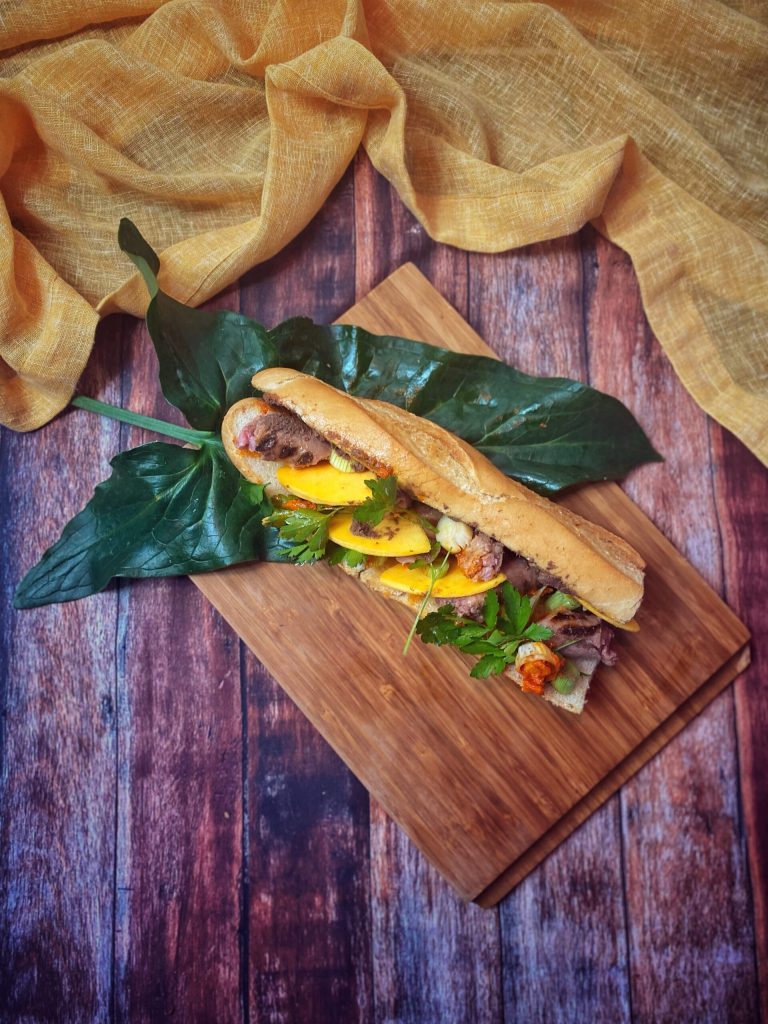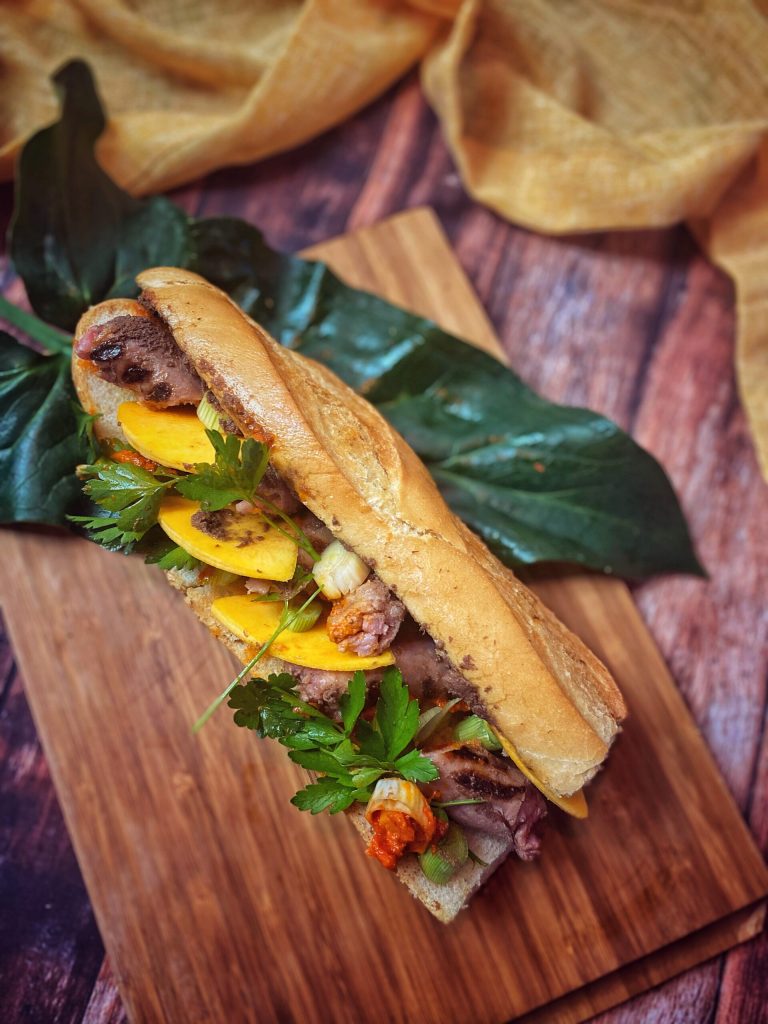Khao jee pâté is a Laotian sandwich, a baguette with a layer of pork liver pâté, and filled with sai oua, the Laotian sausage, sliced papaya, carrots, shallots or onions, coriander and sometimes jeow bong, a chili sauce.
Also called baguette pâté, it is similar to the bánh mì of Vietnam and the num pang of Cambodia.
It is a famous street food found throughout Laos, born when the baguette was introduced during the French Indochina Government (in 1893).
My choice to include this sandwich in the column “Around the World in 15 Sandwiches” comes following the eighth edition of“Pechino Express: The Dragon Route” which took place in Vietnam, Laos, and Sri Lanka.
Following the race, I realized I knew very little about Laos and its cuisine.
The main Laotian food is steamed sticky rice, eaten with hands.
Laotians eat more sticky rice than any other people worldwide, they often refer to themselves as “luk khao niaow” meaning: “children/descendants of sticky rice”.
Galangal, lemongrass, and padaek (fermented fish sauce) are other important ingredients in Laos cuisine.

- Difficulty: Easy
- Preparation time: 10 Minutes
- Portions: Person
- Cooking methods: Grill
- Cuisine: Asian
- Seasonality: All seasons
Ingredients
- 1 baguette
- 5.3 oz sai oua (or spiced pork sausage)
- 1/2 papaya
- 1 carrot
- 1 shallot (or 1/4 onion)
- to taste coriander (fresh)
- 1/2 cucumber (optional)
- to taste pork liver pâté
- to taste jeow bong (or chili sauce)
Steps
Grill the sausage and slice it.
Split the baguette lengthwise, spread the pork liver pâté, add the sliced sausage, sliced papaya, julienned carrot, shallot (or onion), and whole coriander (optional cucumber).
If desired, add the jeow bong sauce.

Khao jee pâté should not be confused with Khao jee, another popular traditional Laotian food, made from steamed sticky rice formed into patties coated with an egg mixture, seasoned and grilled.
Khao jee pâté should not be confused with Khao jee, another popular traditional Laotian food, made from steamed sticky rice formed into patties coated with an egg mixture, seasoned and grilled.
FAQ (Questions and Answers)
Where do the people of Laos come from?
The people of Laos originally came from a northern region that is now part of China.
As they moved southward, they brought along their traditions.
Due to historical migrations of the Laotian people from Laos into neighboring regions, Laotian cuisine has influenced the Northeast region of Thailand, and Laotian foods have also been introduced in Cambodia and Northern Thailand.Which cuisine has most influenced Laotian cuisine?
Like most nations in Southeast Asia, Laos has been heavily influenced by Indian and Chinese cultures.
From time immemorial, Laotian people traded directly with ancient China. However, it was the Indianization of Laos that had the greatest impact.
The spread of Hinduism, Buddhism, and Islam in Southeast Asia during this period brought Indian traditions and culture not only to Laos but also to what is now Indonesia, Malaysia, Singapore, Thailand, Myanmar, and Cambodia, where they took root.
It is also during this period that Buddhist monks introduced traditional Indian spices, curry, and coconut milk to Laos.
However, unlike most of its neighbors, the Laotian affinity for sticky rice ensured that coconut milk and noodles never played a significant role in Laotian cuisine.
Laotian food differs from neighboring cuisines in several ways.
One is that a Laotian meal almost always includes a large amount of fresh raw vegetables, served on the side.
Another is that savory dishes are never sweet. “Sweet and sour” is generally considered odd and foreign in Laos.
Another is that some dishes are bitter. There’s a saying in Laotian cuisine, “van pen lom; khom pen ya“, which can be translated as “sweetness brings you down; bitterness is medicine”.
Another distinctive feature of Laotian food is that it is often eaten at room temperature.
This can be attributable to the fact that Laotian food served with sticky rice is traditionally handled with hands.What is the preferred cooking method in Laotian cuisine?
Ping means grilled.
Grilling is the preferred cooking method for Laotians.
Ping gai is grilled chicken, ping sin is grilled meat, and ping pa is grilled fish.
Before grilling, the meat is typically seasoned with minced garlic, chopped coriander root, minced galangal, salt, soy sauce, and fish sauce.What are the most famous dishes of Laos?
The most famous Lao dish is larb (Lao: ລາບ), a spicy mix of marinated meat or fish (sometimes even raw) with a variable combination of herbs, vegetables, and spices, also typical of Thailand, where it is mainly prepared with pork.
Another widespread dish is the salty and spicy green papaya known as tam mak hoong (Lao: ຕໍາໝາກຫຸ່ງ) or som tam.
Among the desserts, a noteworthy dish is sangkhaya, a cream made from coconut, sugar, and eggs, which is also part of the Thai, Portuguese, and Malaysian tradition.What is Sai oua?
Sai oua (Lao: ໄສ້ອັ່ວ), refers to a popular type of Laotian sausage made with coarsely chopped fatty pork seasoned with lemongrass, galangal, kaffir lime leaves, shallots, coriander, chilies, garlic, salt, sticky rice, and fish sauce.
Sai oua is an ancient Laotian word for sausage, literally sai (intestine) oua (stuffed).
Laotian sausage, or Sai uou, is a broad term used to describe the local variant of Laotian-style sausages found in Laos, the north, and northeast of Thailand.

